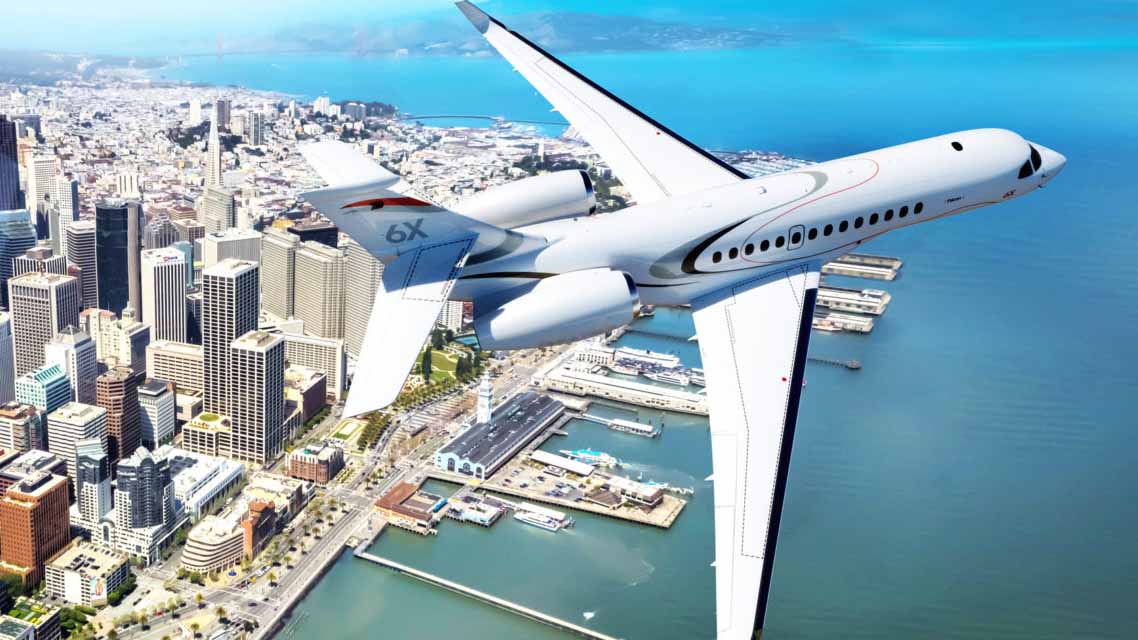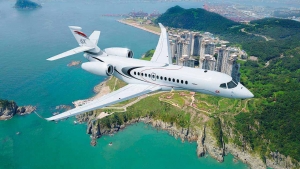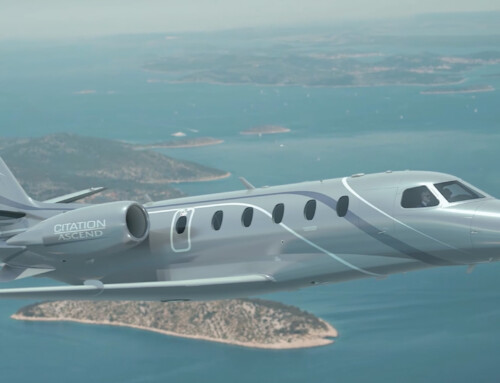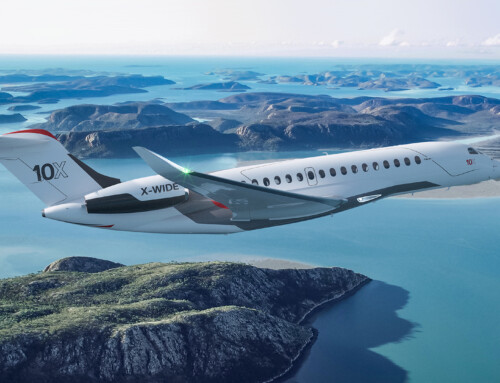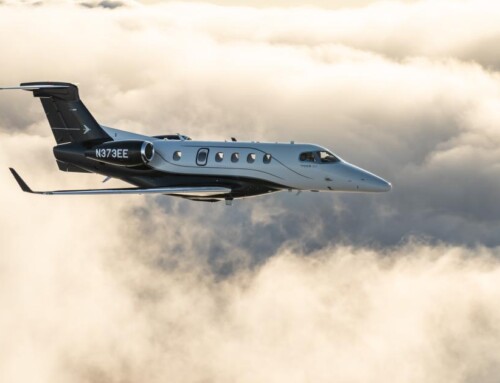Time does not wait. Rather paradoxically, this quote from Lenin has never been more poignant than for Dassault and the launch of their new Falcon 6X on 28th February 2018. In fact, the manufacturer has precious little time when faced with competition and following the delays in the 5X program and their decision to stop the latter in December 2017.
Never mind. Dassault has been through worse. The Falcon 5X program will leave its mark within the manufacturer’s ranks for sure. But its years of development will not, in fact, be in vain… Far from it. The advent of the Falcon 6X tends to show the manufacturer’s incredible flexibility and the fact that it remains a front-runner in the latest high-end aircraft race. Less than two months will have elapsed between the official announcement of the discontinuation of the Falcon 5X program and the public presentation ceremony of the Falcon 6X. An all-time record.
Quick decision
The decision to launch the aircraft’s program was taken in September 2017 just as Dassault’s management was told by Safran that an additional delay was expected on the SilverCrest. Such a delay was inconceivable for the aircraft manufacturer who has already “sacrificed” more than three years on its initial schedule. This resulted in all hands on deck for the consulting firms of the St Cloud aircraft manufacturer, who were under pressure to find new solutions. Dassault needed to once again be present in this market segment which the French aircraft manufacturer could not leave to its only competitor Gulfstream. At the NBAA convention, Dassault Aviation approached Pratt & Whitney Canada (P&WC) to find a replacement engine. A derivative of the P&WC PW800, the PW812D was proposed by the engine manufacturer and selected by the aircraft manufacturer. The beginning of the 6X program was launched. With time running out, the clover brand’s engineers started from the previous program and partially redeveloped a new aircraft with new specifications in less than five months.
“The PW812D was the best fit and we optimized an aircraft that could benefit from this more powerful engine. All in a very short time” says Eric Trappier, CEO of Dassault Aviation, before adding: “With the Falcon 5X we had a good base and had to adapt and optimize the aircraft with this new reactor. As the latter is more powerful and a little heavier than the SilverCrest, we had to slightly modify the design and in particular the rear part of the fuselage.”
Out-of-class
The Falcon 6X does indeed keep the advantages of the 5X program. However, as Olivier Villa points out, “from its predecessor, the Falcon 6X actually only keeps the drift, the cockpit and the width of the fuselage”. The characteristics that made the “success” of the 5X with customers are therefore found on the new aircraft, starting with the 2.18 m width of the fuselage, the largest of all categories combined, and in particular compared to the G650 which is 2.13 m. Dassault took advantage of this new program to offer a cabin which is longer than the previous one for a total of 12.30 m against 11.79 on the 5X. With a height of 1.98m, the cabin of the Falcon 6X, which can accommodate up to 16 passengers in optimal configuration, undeniably offers an unparalleled space for its sector. However, like the previous program, the Falcon 6X is still an out-of-class aircraft because of its interior dimensions and its performance. If the cabin actually competes with an aircraft like the G650, the 5,500nm (10,186 km) range of the new Falcon is to be compared with that of its direct competitor, the Gulfstream G500. The St Cloud firm’s new jet will be able to connect Los Angeles to Geneva or Beijing to San Francisco in one journey with 8 passengers on board.
Falcon 6X Innovations
This aircraft gives a performance which meets the market trends which Dassault had correctly identified at the time for the launch of the 5X. Specifically, and despite the 15 official cancellations of the latter, the French aircraft manufacturer remains confident with the market potential of its new aircraft. The 6X is based on the positive feedback that the Falcon 5X had received throughout its program. The Falcon 6X, with a more spacious cabin, should therefore allow Dassault to come back very strongly in the race. All the more so as the St Cloud engineers have worked on the integration of new technologies and the redesign of main elements such as the wing. It has been completely revised both in terms of its profile and its design in order to minimize the impact of turbulence, and will be equipped with “flaperons”, a term combining flaps and ailerons, a legacy of fighter planes. This system is located in the center of the trailing edge of the wing and allows the aircraft to increase its drag without loss of lift or speed. The “flaperons” along with all the mobile surfaces of the wing will now be managed by digital flight controls. A first for Dassault’s civilian range that will allow the Falcon to improve the control of steep approaches and slow speed (109 Kts – 202 km / h) particularly on short terrain. As such, the Falcon 6X is already planned to operate from and to the iconic London City Airport in the heart of the UK capital. In addition to improving performance, this new wing will also be equipped with a new fire protection safety device. The Falcon 6X will be the first business jet to use a nitrogen-generating system to fill the space above the remaining fuel with an inert gas, providing better protection against ignition. In addition, the structural aspect of the aircraft’s innovation is also at the heart of the cockpit. The aircraft manufacturer continues the development of the third generation of EASy digital avionics started with the 5X, which already has a few hours of flight. The arrival of the Falcon 6X signifies the de facto integration of systems previously planned as an option on the 5X. In fact, the 6X will be proposed with the FalconEye system developed in collaboration with Elbit, combining synthetic vision (SVS) with infrared vision (IR) as well as the electronic management device or EFB – Electronic Flight Bag – FalconSphere II. To perfect its jet, the aircraft manufacturer also relied on a new “standard” in the field of maintenance with the FalconScan system. This is derived from test facilities and allows for a real-time diagnostic of all parameters during flight. Connected to computers via an Ethernet network, it continuously measures more than 10,000 parameters on the aircraft, indicating the root cause in case of problems. Dassault left nothing to chance and used a broad spectrum of technological and aerodynamic innovations to design this new flagship.
Revitalization of the cabin
Like the falcon 5X, the falcon 6X is the first aircraft in the Falcon range designed around its cabin, as Eric Trappier points out: “The industry’s trend is towards more spacious interiors and high ceilings, and that’s exactly what customers have been praising about our new Falcon”, before adding: “So we designed the Falcon 6X around the cabin, putting the passenger in the center, while offering high performance and flying qualities that customers appreciate about our new Falcons”. The studio’s management was not content with a simple recovery of the Falcon 5X’s cabin design. The studio, led by Agnes Gervais, Interior Design Manager at Dassault Falcon, was inspired by the latest creations made for the Falcon 900LX and presented in October 2016. In fact, and despite the few years that separate the cabin design of the Falcon 5X and 6X, the interior of the new jet concentrates on a much curvier design than that of its predecessor. According to the head of design, it responds as closely as possible to the aesthetic aspirations of the moment, in particular by integrating technologies into the design in order to purify the lines as much as possible. In addition, the design studio has highlighted the lighting effects as emphasized by Agnes Gervais: “We paid special attention to light and colors, especially in the entrance” The judicious balance between contrast and brightness could have been brought by the Skylight, an electro-chromatic zenithal rooflight at the entrance of the aircraft, but also by the 28 portholes, 10% larger than those of the Falcon 8X, running along the fuselage. The strength of this design, reinvented for the occasion, runs through this large interior space of 52.2 m3 which is divisible into three living areas. The rear design allows for, among other things, the development of a personal suite with the possibility of transforming the seat into a bed. The crew is not forgotten since Dassault offers, for long-distance flights, an optional crew rest area, located at the front of the aircraft.
For Dassault Aviation, the announcement of the launch of the Falcon 6X is particularly crucial when faced with their competition. In fact, the aircraft manufacturer could not leave the market needs unanswered and wait for the next Ebace exhibition for the announcement of this new program. Although larger and of new design, the new jet will indeed be the “replacement” of the ephemeral Falcon 5X as underlines Olivier Villa, the Civil Aircraft General Manager at Dassault, who indicates that with the 6X, “This is not a different market vision to the Falcon 5X.”
Different thanks to a cabin which perfectly meets the market’s expectations and gives the flexibility of use which has made the name of the clover brand, the Falcon 6X is marketed at a unit price of $47 million, and will be no doubt be the spearhead of the manufacturer’s catalog and certainly one of the most promising aircrafts in terms of sales in the wide-cabin aircraft market sector.
The PW812D: a practical choice
On the engine side, it’s a homecoming or at least familiar ground for Dassault, who already equips the Falcon 2000 and the 7X / 8X series with a Pratt & Whitney Canada (PWC) engine. Certainly, the PW812D, which will equip the Falcon 6X, is less innovative than the ambitious Safran program. But pragmatism is now de rigueur in the French aircraft manufacturer after the hard lessons learned on the 5X program. The heart of the issue in the design of the aircraft remains well on the side of the engine for those who doubt it. With the selection of the Canadian engine, which displays between 13,000 and 14,000lbs of thrust, Dassault Aviation has to review much of the design of the aircraft in record time. If the PW812D is still in the initial stage of development, the engine manufacturer, however, said they took the lead and completed more than 200 hours of bench testing to respond, well before the launch of the Falcon 6X, to a niche market that was previously unoccupied. In fact, the launch of the Falcon 6X is also that of this version derived from the PurePower PW800 which already equips the Gulfstream G500 and G600 with respectively the PW814 and 815 versions. The PW812 version, identical to these predecessors but of a smaller build, is differentiated by the use of the same gas generator as the MRJ regional aircraft. The smallest of the 16 products already in service worldwide and which has already accumulated more than 585,000 flying hours in service, this version of the engine is found with a reduced monobloc blower of 44 inches against 50 for the version equipping the two Gulfstream aircrafts. The performance of this new engine should allow not only for a decrease in carbon emissions but also a reduction in noise of 15EPNd -Effective Perceived Noise (EPNdB) – below the Stage 4 standard. Its efficiency, related to the new generation of engine, should also allow for a reduction in costs per hour of flight that the aircraft manufacturer estimates at about $ 3,700, 5% lower than the Gulfstream G500. For now, Pratt & Whitney Canada says it is working closely with Dassault to meet the manufacturer’s commitment deadlines not only for the date of the first scheduled flight in early 2021 but also for the commissioning of the aircraft announced in December 2022.
Source: ULTIMATEJET

 Hawker-Beechcraft Hawker 400XP
Hawker-Beechcraft Hawker 400XP Cessna Citation V
Cessna Citation V Beechcraft Premier IA
Beechcraft Premier IA Beechcraft King Air 350
Beechcraft King Air 350



